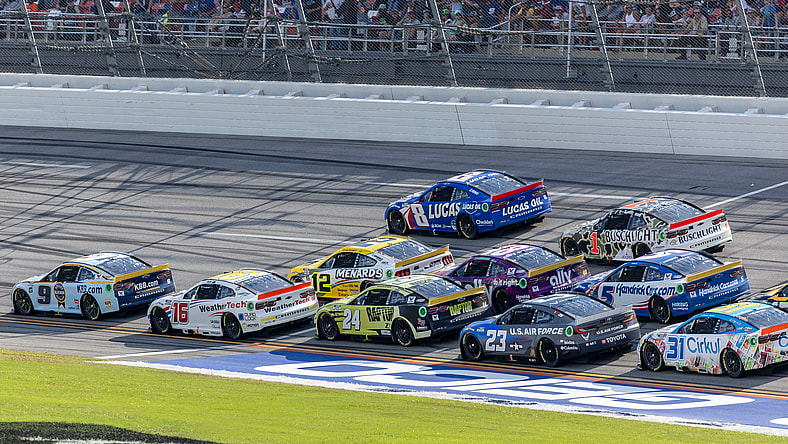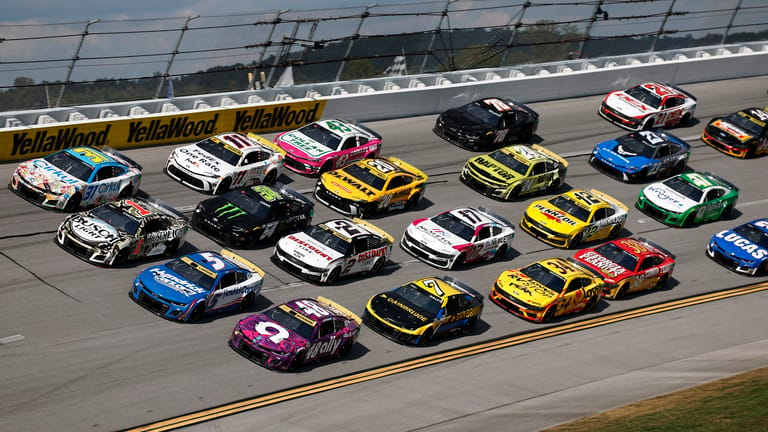
Sure, the superspeedway racing product in the NASCAR Cup Series right now isn’t for everyone and very well might not be for most people but it is still one of the most awe-inspiring visuals in all of professional motorsports.
Even armed with the understanding that the field was only four-wide because they were half-throttle under fuel conservation orders, the below image served as a reminder of just how dynamic the highest level of stock car racing is.

It’s something to appreciate even as the industry is knee-deep in working to solve the puzzle that is the seventh-generation car at pretty much every track on the schedule.
With that said, every week is a radically different experience! This isn’t to put down sports car racing or the current road and street course heavy IndyCar product but those weekly experiences feel like largely the same flavor of entertainment.
And if you like that dish, you are certainly free to enjoy it, but watching races on television from Mid-Ohio and Barber largely tastes like eating the same fruit at different ripeness.
Only in NASCAR can you see races in quarter-mile football stadiums, on half-mile short ovals, three-quarters short tracks, one milers, a 1.3-miler, intermediates, a two-miler, superspeedways, road courses, a street course and even dirt every now and then.
For the longest time, the intermediate package was not that compelling and there were other things to satiate the NASCAR appetite instead. So even now, as the industry especially tries to figure out short tracks and superspeedways, this is just a moment to appreciate NASCAR’s continued schedule diversity.
There is no buffet like NASCAR.
Is this a problem?
Now, with the above said, the day after figuratively eating the racing on superspeedways right now feels like it gives you food poisoning.
Just when you think these races can’t get any more random and unpredictable, producing a winner in the worst performing team in the garage at Daytona in August, Sunday at Talladega produced literally the biggest crash by volume in the history of the sport.
28 cars.
It’s been detailed ad nauseam over the past two years, but the cars have so much drag that it punishes any driver for making a move and trying to go forward, thus producing the current ride around and save fuel approach with the goal of gaining track position on pit road instead.
It certainly won the race on Sunday as Mike Kelley got Stenhouse out front, and even though his door paid the price for it, the No. 47 stayed out front and won the race in overtime.
“I didn’t even have fun today,” said Joey Logano after his involvement in the big crash. “You can’t even do anything here. You’re running four-wide, that looks cool but you’re running half throttle and then when you want to go and it’s time to go, everyone’s just stuck two-wide. So, there’s just not many moves you can make. You just keep trying to re-learn how to run on these superspeedways as it evolves but the car has just got so much drag on it, you can’t make many moves, make runs happen and cross people up. You’re committed to where you are in that line.”
Did Christopher Bell think it was good?
“I don’t know, Matt,” Bell said. ‘Insider the car, I thought Bristol was a good race and fans said it was a terrible race. Inside the car, this one felt like a terrible race but fans, I’m sure, are going to say it was a great race.
“So I don’t know.”
Chris Gaebhart, crew chief of the No. 11 for Denny Hamlin, said that talent just doesn’t shine with the current superspeedway product.
“With Gen 7 speedway racing, I just don’t see any greatness,” Gabehart said. “There’s qualifying up front, there’s a little bit of a tussle after an event. So, green flag comes out or a pit cycle just completes and there’s a little bit of flustering. But once they get all lined up, you’re just stuck. There’s no more driver ability, not more driver talent to speak of. I mean, we’re talking about very small things. So, it’s all about green flag pit cycles and strategy and fuel mileage and stuff. To the point of can they fix it? I mean, if we’re looking for racing to be what we care about.
“If we want – racing purists want to see so many different disciplines of racing throughout a Cup Series schedule. That’s what sets Cup Series apart, right? [That] there’s so many different types of racing these guys have to be good at and it’s the only schedule in the world where that’s true. If we want driver racing discipline to matter at these tracks, we have to do something. I am a proponent of making the stage lengths the length of the fuel tank. So, all of the pitting that’s necessary to be done is under caution. Because we all have fuel to make it to the caution that we care about. There’s some race length challenges that we’d have to work through there as an industry, but I’m confident we can do it.”
Hamlin has said repeatedly that this generation of car does not play to his strengths as a superspeedway racer, and certainly, his results and performance is not what it was on the other car. At the same time, Stenhouse has two wins with the old car at Daytona and Talladega and two wins with this car too, and is always a contender.
Does he feel like this car took anything away from his particular skill set?
“I think there’s definitely things that are different and nuances of this car at every racetrack,” Stenhouse said. “No different than when they add a little bit taller wicker down the car and things like that. You feel things a little bit different even than the last time we were here.
“So I think for the most part I think the 12, the 6, 22, myself, I feel like we always tend to work ourselves in the mix. Every time I looked up, the 22 is right there, the 6 was right there, or the 17 and the 12 and myself.
“I think for me there’s little things that are still possible to do with this car with the side drafts and trying to figure out when to side draft and not to side draft. It’s still effective but not as effective, I guess.”
At the end of the day, especially in the current championship structure, these races are always going to be about surviving to the end and then making a series of potentially risky decisions that could either win the race or cause a 25-car pileup.
That’s universal across all four national touring divisions.
Stretching credibility
What are we doing here, NASCAR?
Three weeks after defending the decisions made at Watkins Glen, and then again at Kansas, no matter how nonsensical the Damaged Vehicle Policy versus Flat Tire Recovery Policy looked in implementation, the league completely reversed course on everything it said about how it would be enforced for the rest of the season on Sunday at Talladega.
Even when confronted with the scenario of what would happen if this happened to a final four driver, NASCAR said it would stay the course until a better solution was formulated during the off-season. No matter how goofy and awkward the towing of Josh Berry looked last week, the response was accurate and fair to precedence.
But then it actually did happen to two active Cup Series playoff drivers in Chase Elliott and Chase Briscoe and a new policy was made up on the spot and that’s impossible to defend in the pursuit of a legitimate spot.
They were towed to pit road with crash damage, allowed to continue, and even given extra time to work on the cars as the red flag was lifted with the pace car not rolling.
It was a complete breakdown in legitimacy.
That’s to say nothing of the decision to keep Ricky Stenhouse Jr. on the track with a hole in his door and door foam missing. It’s to say nothing of scuttlebutt that the technical inspection process has started to become more and more inconsistent.
Not even discussing the lawsuit, this was a bad week for NASCAR, just how the racing product and how series officials managed the race on Sunday.
The scrutiny is deserved because NASCAR has decided to crown champions using three-race sample size and loading those rounds with superspeedways and road courses. It’s already stretching credibility and it was made worse with how the race was officiated on Sunday.
There is a lot to appreciate about this format, and it’s been written here on two different occasions this summer, but the officiating at this point of the playoffs is becoming just as absurd as its schedule and NASCAR really needs to clean it up.
Elton Sawyer is a good dude, and an admirable official who knows racing as good as anyone in that office, but he is becoming way too much of a main character this summer due to the infrastructure around him and that is increasingly disappointing.
Fun fact
Despite all the chaos of the first round and a half, the current top eight in the Round of 12 mirror the same top eight in overall points scored throughout the entire NASCAR Cup Series season.
It’s a testament to how much regular season success does matter in terms of seeding and playoff points earned, but also the cream inevitably rising to the top more often than not, even in a format designed to create randomness and instability.
